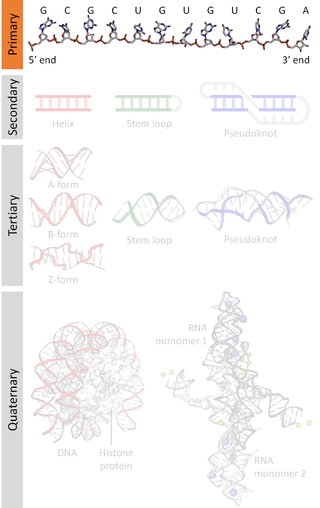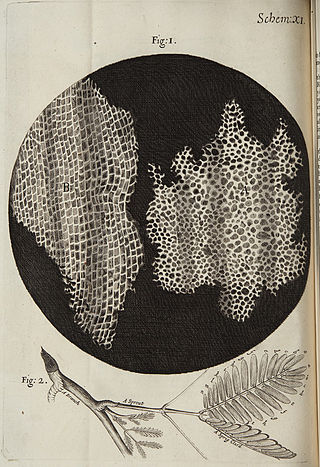Related Research Articles

In biochemistry, allosteric regulation is the regulation of an enzyme by binding an effector molecule at a site other than the enzyme's active site.
In biology, quorum sensing or quorum signaling (QS) is the ability to detect and respond to cell population density by gene regulation. Quorum sensing is a type of cellular signaling, and more specifically can be considered a type of paracrine signaling. However, it also contains traits of both autocrine signaling: a cell produces both the autoinducer molecule and the receptor for the autoinducer. As one example, QS enables bacteria to restrict the expression of specific genes to the high cell densities at which the resulting phenotypes will be most beneficial, especially for phenotypes that would be ineffective at low cell densities and therefore too energetically costly to express. Many species of bacteria use quorum sensing to coordinate gene expression according to the density of their local population. In a similar fashion, some social insects use quorum sensing to determine where to nest. Quorum sensing in pathogenic bacteria activates host immune signaling and prolongs host survival, by limiting the bacterial intake of nutrients, such as tryptophan, which further is converted to serotonin. As such, quorum sensing allows a commensal interaction between host and pathogenic bacteria. Quorum sensing may also be useful for cancer cell communications.

A nucleic acid sequence is a succession of bases within the nucleotides forming alleles within a DNA or RNA (GACU) molecule. This succession is denoted by a series of a set of five different letters that indicate the order of the nucleotides. By convention, sequences are usually presented from the 5' end to the 3' end. For DNA, with its double helix, there are two possible directions for the notated sequence; of these two, the sense strand is used. Because nucleic acids are normally linear (unbranched) polymers, specifying the sequence is equivalent to defining the covalent structure of the entire molecule. For this reason, the nucleic acid sequence is also termed the primary structure.

Förster resonance energy transfer (FRET), fluorescence resonance energy transfer, resonance energy transfer (RET) or electronic energy transfer (EET) is a mechanism describing energy transfer between two light-sensitive molecules (chromophores). A donor chromophore, initially in its electronic excited state, may transfer energy to an acceptor chromophore through nonradiative dipole–dipole coupling. The efficiency of this energy transfer is inversely proportional to the sixth power of the distance between donor and acceptor, making FRET extremely sensitive to small changes in distance.

In telecommunications, visible light communication (VLC) is the use of visible light as a transmission medium. VLC is a subset of optical wireless communications technologies.

Protein–protein interactions (PPIs) are physical contacts of high specificity established between two or more protein molecules as a result of biochemical events steered by interactions that include electrostatic forces, hydrogen bonding and the hydrophobic effect. Many are physical contacts with molecular associations between chains that occur in a cell or in a living organism in a specific biomolecular context.

Neurotransmission is the process by which signaling molecules called neurotransmitters are released by the axon terminal of a neuron, and bind to and react with the receptors on the dendrites of another neuron a short distance away. A similar process occurs in retrograde neurotransmission, where the dendrites of the postsynaptic neuron release retrograde neurotransmitters that signal through receptors that are located on the axon terminal of the presynaptic neuron, mainly at GABAergic and glutamatergic synapses.
Mutual authentication or two-way authentication refers to two parties authenticating each other at the same time in an authentication protocol. It is a default mode of authentication in some protocols and optional in others (TLS).
Signal interfering DNA (siDNA) is a class of short modified double stranded DNA molecules, 8–64 base pairs in length. siDNA molecules are capable of inhibiting DNA repair activities by interfering with multiple repair pathways. These molecules are known to act by mimicking DNA breaks and interfering with recognition and repair of DNA damage induced on chromosomes by irradiation or genotoxic products.

Olfactory receptor 1G1 is a protein that in humans is encoded by the OR1G1 gene.

Olfactory receptor 5P3 is a protein that in humans is encoded by the OR5P3 gene.

Tetherin, also known as bone marrow stromal antigen 2, is a lipid raft associated protein that in humans is encoded by the BST2 gene. In addition, tetherin has been designated as CD317. This protein is constitutively expressed in mature B cells, plasma cells and plasmacytoid dendritic cells, and in many other cells, it is only expressed as a response to stimuli from IFN pathway.

A nanonetwork or nanoscale network is a set of interconnected nanomachines, which are able to perform only very simple tasks such as computing, data storing, sensing and actuation. Nanonetworks are expected to expand the capabilities of single nanomachines both in terms of complexity and range of operation by allowing them to coordinate, share and fuse information. Nanonetworks enable new applications of nanotechnology in the biomedical field, environmental research, military technology and industrial and consumer goods applications. Nanoscale communication is defined in IEEE P1906.1.
Within bioinformatics, intrinsic Noise Analyzer (iNA) is an open source software for studying reaction kinetics in living cells. The software analyzes mathematical models of intracellular reaction kinetics such as gene expression, regulatory networks or signaling pathways to quantify concentration fluctuations due to the random nature of chemical reactions.

In molecular biology mir-3180 microRNA is a short RNA molecule. MicroRNAs function to regulate the expression levels of other genes by several mechanisms. The mir-10 microRNA precursor is a short non-coding RNA gene that is part of an RNA gene family which contains mir-3180-1, mir-3180-2, mir-3180-3, mir-3180-4 and mir-3180-5. They have now been predicted or experimentally confirmed in a wide range of cancers in humans. mir-3180 has currently only been identified in human Homo sapiens.
Multi-state modeling of biomolecules refers to a series of techniques used to represent and compute the behaviour of biological molecules or complexes that can adopt a large number of possible functional states.

Ganesh Bagler is known for his research in computational gastronomy, an emerging data science of food, flavors and health. By blending food with data and computation he has helped establish the foundations of this niche area. Starting with the investigation of food pairing in the Indian cuisine, his lab has contributed to computational gastronomy with studies on culinary fingerprints of world cuisines, culinary evolution, benevolent health impacts of spices, and taste prediction algorithms.

Olfactory receptor family 1 subfamily E member 3 (gene/pseudogene) is a protein that in humans is encoded by the OR1E3 gene.
Accessory gene regulator (agr) is a complex 5 gene locus that is a global regulator of virulence in Staphylococcus aureus. It encodes a two-component transcriptional quorum-sensing (QS) system activated by an autoinducing, thiolactone-containing cyclic peptide (AIP).

Intercellular communication (ICC) refers to the various ways and structures that biological cells use to communicate with each other directly or through their environment. Different types of cells use different proteins and mechanisms to communicate with one another using extracellular signalling molecules. Components of each type of intercellular communication may be involved in more than one type of communication making attempts at clearly separating the types of communication listed somewhat futile. The sections are loosely compiled from various areas of research rather than by a systematic attempt of classification by functional or structural characteristics.
References
- ↑ T. Nakano, A. Eckford, and T. Haraguchi (2013). Molecular Communication. Cambridge University Press. ISBN 978-1107023086.
{{cite book}}: CS1 maint: multiple names: authors list (link) - 1 2 3 "Text message using vodka: Molecular communication can aid communication underground, underwater or Inside the Body". Phys.org. Retrieved 18 October 2016.
- ↑ Farsad, N.; Guo, W.; Eckford, A. W. (2013). Willson, Richard C (ed.). "Tabletop Molecular Communication: Text Messages through Chemical Signals". PLOS ONE. 8 (12): e82935. arXiv: 1310.0070 . Bibcode:2013PLoSO...882935F. doi: 10.1371/journal.pone.0082935 . PMC 3867433 . PMID 24367571.
- ↑ Habibi, Iman; Emamian, Effat S.; Abdi, Ali (2014-10-07). "Advanced Fault Diagnosis Methods in Molecular Networks". PLOS ONE. 9 (10): e108830. Bibcode:2014PLoSO...9j8830H. doi: 10.1371/journal.pone.0108830 . ISSN 1932-6203. PMC 4188586 . PMID 25290670.
- ↑ "NEW WIRELESS TECHNOLOGY FOR DATA TRANSMISSION IN CHEMICAL SYSTEMS" (PDF). oaji.net.